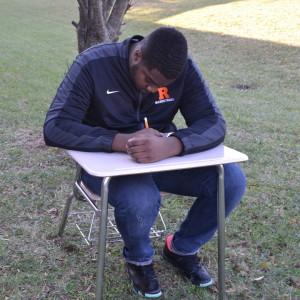Bringing Classroom Experience Outdoors
December 13, 2013

Average American teens are seen by society as overweight, overworked and most importantly, out of touch with nature.
Teenagers get exposed to innovative technology on a daily basis, but according to the National Wildlife Foundation, kids today are spending about half as much time outdoors as they did 20 years ago.
Sixth grade students participate in a county-wide Outdoor Education program, which is meant to get kids interested in nature. However, the great outdoors are often not incorporated in the routines of high schoolers; classes that take students out of the building are rare.
There are certain procedures teachers have to take before conducting a class outside. They must inform security, be assigned a walkie-talkie and pick a day with good weather conditions. In addition, certain classes may not be taken outside for fear of behavior issues.
“It was something that we would do maybe once a semester. I’ve thought about doing it more often because it’s so good to get outside,” English teacher Anne Ehlers said. “It’s hard to plan it for sure. Sometimes it’s freezing or it’s raining; it’s very unpredictable.”
When her class was studying Annie Dillard’s writing–which often focused on nature and natural elements–last year, senior Karen Kane’s IB English class went outside to try and mimic Dillard’s writing about nature.
“It was enjoyable to a certain extent. It was great to get out of the classroom and outside for a while a�� I had fun with it,” Kane said of the experience.
Ehlers also said it is often hard for some teachers to break their routines. Incorporating an outdoor class into the curriculum can be difficult, especially in rigorous academic classes such as AP or IB. However, Ehlers found some time for her AP Language and Composition class to enjoy the outdoors in a way that corresponded to the current lesson.
“I enjoyed getting out, especially when we were studying Thoreau because he was a nature boy, so it fit,” Ehlers said. “I think [students] really like [going outside], so it’s a nice treat. You also learn a lot about kids. You learn the ones who love to be outside and the ones who don’t want to get their shoes dirty.”
Junior Ben Neely recalled only one time when he went outside for his biology class his freshman year. He and his class had gone outside to study plants because their current unit was focused on ecosystems.
“Doing activities outside can be helpful, especially for classes like science,” Neely said. “[But] if we had more classes outside, it would be very distracting.”
One reason teachers try to schedule to have some of their classes outside is because their students do not spend enough time outside during their own free time.
“[Our generation does not get enough outside time] definitely because of technology. Technology is taking over the world. Kids are not as involved in outdoor activities,” Kane said. “I remember when I was little, I would spend so much time outside playing and now I see all these little kids on their iPhones.”
America is concerned with kids’ appreciation of nature more than ever. “It’s really sad. It’s really sad that the younger generation is not getting enough outdoors time,” Ehlers said. “Outdoor Education does some of the [nature appreciation] stuff, but we need more of it.”


